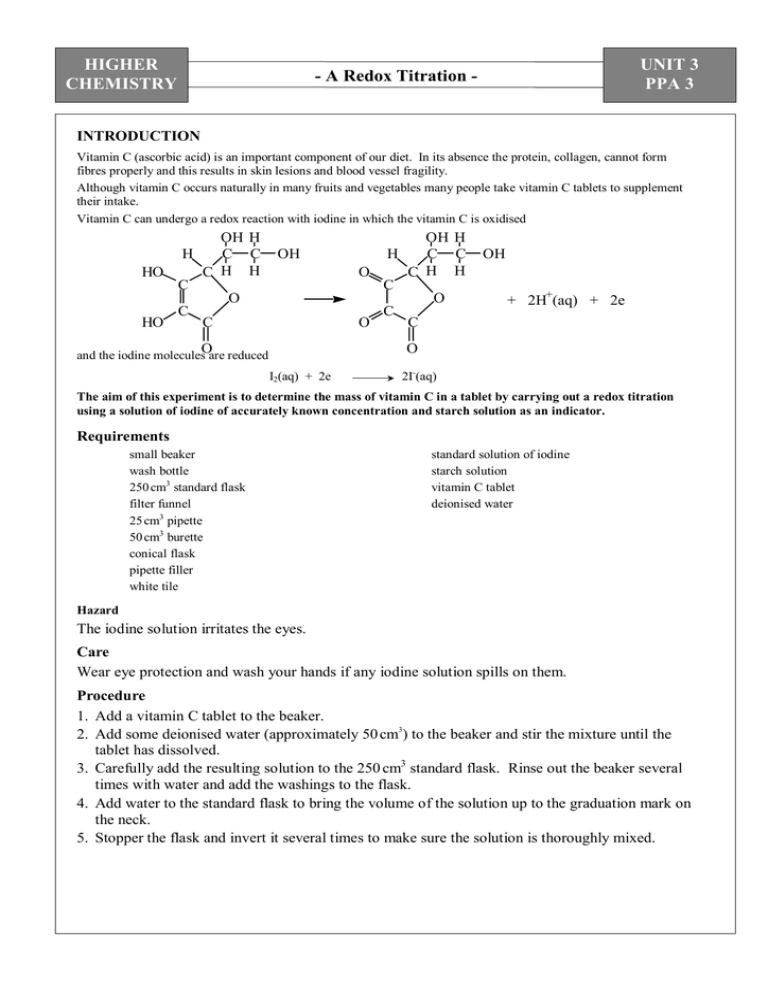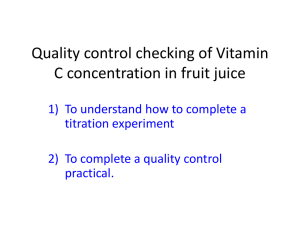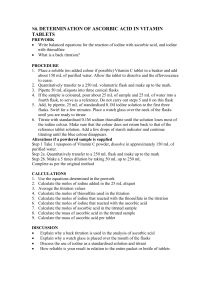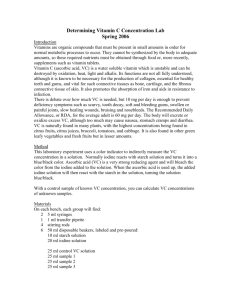HIGHER UNIT 3 CHEMISTRY PPA 3
advertisement

HIGHER CHEMISTRY UNIT 3 PPA 3 - A Redox Titration - INTRODUCTION Vitamin C (ascorbic acid) is an important component of our diet. In its absence the protein, collagen, cannot form fibres properly and this results in skin lesions and blood vessel fragility. Although vitamin C occurs naturally in many fruits and vegetables many people take vitamin C tablets to supplement their intake. Vitamin C can undergo a redox reaction with iodine in which the vitamin C is oxidised H HO OH H C C C H H OH H O C OH H C C C H H C O HO C O C O O C OH + 2H+(aq) + 2e C O and the iodine molecules are reduced I2(aq) + 2e 2I-(aq) The aim of this experiment is to determine the mass of vitamin C in a tablet by carrying out a redox titration using a solution of iodine of accurately known concentration and starch solution as an indicator. Requirements small beaker wash bottle 250 cm3 standard flask filter funnel 25 cm3 pipette 50 cm3 burette conical flask pipette filler white tile standard solution of iodine starch solution vitamin C tablet deionised water Hazard The iodine solution irritates the eyes. Care Wear eye protection and wash your hands if any iodine solution spills on them. Procedure 1. Add a vitamin C tablet to the beaker. 2. Add some deionised water (approximately 50 cm3) to the beaker and stir the mixture until the tablet has dissolved. 3. Carefully add the resulting solution to the 250 cm3 standard flask. Rinse out the beaker several times with water and add the washings to the flask. 4. Add water to the standard flask to bring the volume of the solution up to the graduation mark on the neck. 5. Stopper the flask and invert it several times to make sure the solution is thoroughly mixed. HIGHER CHEMISTRY - A Redox Titration - UNIT 3 PPA 3 6. After rinsing the pipette with a little of the vitamin C solution, pipette 25 cm3 of it into the conical flask. 7. Add a few drops of starch solution to the vitamin C solution in the conical flask. 8. After rinsing the burette with a little iodine solution, fill the burette with the iodine solution. 9. Note the initial burette reading. Since the solution has a dark colour, it is difficult to see the bottom of the meniscus. Take the burette reading from the top of the meniscus. 10. Add the iodine solution slowly from the burette whilst gently swirling the solution in the conical flask. Initially you will see a blue/black colour as the iodine reacts with the starch but this will rapidly disappear as the iodine reacts with the vitamin C. 11. Near the end-point of the titration the colour disappears more slowly. At this point add the iodine solution drop by drop until the solution just turns a blue/black colour and remains so. 12. This is the end-point of the titration i.e. all the vitamin C has reacted. Note the final burette reading. 13. Wash out the conical flask. 14. Repeat the titrations until concordant results are obtained. Calculation (a) Knowing the average volume and concentration of the iodine solution used in the redox titration, the number of moles of iodine can be calculated. (b) With the result from step (a) and the balanced equation for the redox reaction, we can work out the number of moles of vitamin C in 25 cm3 of the vitamin C solution. This can be scaled up to find the number of moles of vitamin C in 250 cm3 of the vitamin C solution. (c) Your final answer in step (b) will, of course, be equal to the number of moles of vitamin C in the tablet. Using this result and the mass of one mole of vitamin C (176 g) we can finally work out the mass of vitamin C in the tablet. HIGHER CHEMISTRY Name: - A Redox Titration PC(a) PC(b) PC(c) PC(d) PC(e) Date: UNIT 3 PPA 3 Teacher’s/Lecturer’s Initials - ASSESSMENT SHEET * State the aim of the experiment. PC(b) * Using the molecular formula for vitamin C write equations for the oxidation and reduction halfreactions and hence write a balanced equation for the redox reaction between vitamin C and iodine. Procedure * Write a brief description of the experimental procedure you carried out to determine the mass of vitamin C in a tablet. PC(b) HIGHER CHEMISTRY - A Redox Titration - UNIT 3 PPA 3 Results * Present your results in an appropriate manner. PC(c) Calculation / Conclusion * Carry out a calculation to determine the mass of vitamin C in the tablet. (Ask your teacher/lecturer for a HELP SHEET if you are unsure about how to complete the calculation) PC(d), PC(e) HIGHER CHEMISTRY - A Redox Titration - UNIT 3 PPA 3 - HELP SHEET – CALCULATION Suppose the average titre volume was 22.1 cm3 and the iodine solution had a concentration of 0.0250 mol l-1. From the average titre volume in litres (V) and the concentration of the iodine solution (C), we can calculate the number of moles of iodine (n) used in the titration: n(iodine) = C x V = 0.0250 x 0.0221 5.525 x 10-4 mol = We can now use the balanced redox equation to calculate the number of moles of vitamin C in a 25 cm3 sample of the vitamin C solution: C6H8O6 + 1 mol C6H6O6 + 2H+ + 2I- I2 1 mol 5.525 x 10-4 mol 5.525 x 10-4 mol But there were 250 cm3 of vitamin C in total and so to determine the number of moles of vitamin C in the tablet we have to scale up our last answer: n(vitamin C) per tablet = 10 x 5.525 x 10-4 = 5.525 x 10-3 mol Vitamin C: C6H8O6 Mass of 1 mole = 6(12) + 8(1) + 6(16) = 176 g We can now calculate the mass of vitamin C per tablet: Mass of vitamin C per tablet = = 176 x 5.525 x 10-3 0.972 g HIGHER CHEMISTRY UNIT 3 PPA 3 - A Redox Titration - - TEACHER/LECTURER/TECHNICIAN SHEET Requirements per student (or group) Reagents 1 g vitamin C tablet (1) 0.025 mol l-1 iodine solution (~ 75 cm3) (6.35 g iodine and 20 g potassium iodide per litre) iodine harmful 1 % fresh starch solution (as indicator) (Mix 1 g soluble starch to a thin paste with water, then add to 100 cm3 boiling water) deionised water (250 cm3) Apparatus 250 cm3 standard flask (1) 25 cm3 pipette (1) 50 cm3 burette (1) 100 cm3 beaker (1) 100 cm3 conical flask (1) pipette filler (1) filter funnel (1) wash bottle (1) white tile (1) Safety Measures Preparation/provision of: Main Hazards Control Measures 0.025 mol l-1 iodine from solid or ampoule Solid burns eyes and skin; harmful if ingested. Vapour irritates eyes. Wear goggles and pvc gloves. Prepare in ventilated room and keep 1 mol l-1 sodium thiosulphate handy to treat any spills on the skin. HIGHER CHEMISTRY - A Redox Titration - UNIT 3 PPA 3 Notes The iodine solution will require to be standardised. This can be done against a standard solution of sodium thiosulphate. Alternatively, the iodine solution could be prepared from a commercial volumetric standard. Both lemon and orange-flavoured effervescent vitamin C tablets are suitable. Despite the bright orange colour of the latter the end-point of the titration is distinct.








